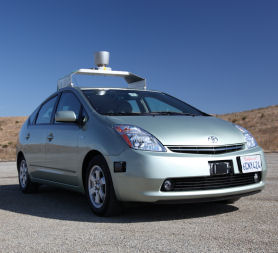Google tests car that drives itself
Internet giant Google has tested a self-driving car on the streets near its Californian headquarters – including taking a spin across San Francisco’s Golden Gate bridge.

The cars use video cameras, radar sensors and a laser range finder to “see” other traffic on the road, and also rely on detailed maps collected earlier with manually driven cars.
On the test drives, a trained safety driver sat in the cars ready to take control if anything went wrong.
In an official Google blog, Engineer Sebastian Thrun wrote: “Larry and Sergey founded Google because they wanted to help solve really big problems using technology.
“And one of the big problems we’re working on today is car safety and efficiency. Our goal is to help prevent traffic accidents, free up people’s time and reduce carbon emissions by fundamentally changing car use.”
Google was founded in 1998 by Larry Page and Sergey Brin and has since grown into the biggest internet company in the world. It has already branched out into maps and phones.
The company also has Google Street View, which has captured thousands of images globally, including 95 per cent of the UK’s roads.
But the car is one of the biggest sidelines yet for the innovative company. The test cars have already logged 140,000 miles – driving on the Pacific Coast Highway, the Hollywood Boulevard, and around Lake Tahoe, among other locations.
Safety first
Mr Thrun said safety was key for the team working on the robot car, and local police had been briefed on the tests.
He said safety was the long-term aim for the vehicle as well.
“According to the World Health Organisation, more than 1.2 million lives are lost every year in traffic accidents. We believe technology has the potential to cut that number, perhaps by as much as half,” he said.
“We’re also confident that self-driving cars will transform car sharing, significantly reducing car usage, as well as help create the new ‘highway trains of tomorrow’…While this project is very much in the experimental stage, it provides a glimpse of what transportation might look like in the future thanks to advanced computer science.
“And that future is very exciting.”
-
Latest news
-
Windrush scandal: returning to the UK after a forty year wait6m

-
Netanyahu ‘survival’ depends on ‘expanding war’ says head of Palestinian National Initiative5m

-
Proposed law change could strip parental rights from paedophiles5m

-
Hugh Grant settles privacy lawsuit against The Sun newspaper publisher2m

-
Post Office Scandal: what did top executive know?6m

-




